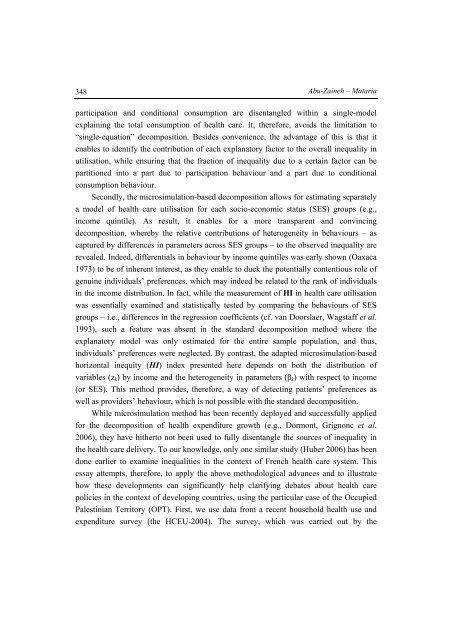The Palestinian Economy. Theoretical and Practical Challenges
The Palestinian Economy. Theoretical and Practical Challenges
The Palestinian Economy. Theoretical and Practical Challenges
Create successful ePaper yourself
Turn your PDF publications into a flip-book with our unique Google optimized e-Paper software.
348<br />
Abu-Zaineh – Mataria<br />
participation <strong>and</strong> conditional consumption are disentangled within a single-model<br />
explaining the total consumption of health care. It, therefore, avoids the limitation to<br />
“single-equation” decomposition. Besides convenience, the advantage of this is that it<br />
enables to identify the contribution of each explanatory factor to the overall inequality in<br />
utilisation, while ensuring that the fraction of inequality due to a certain factor can be<br />
partitioned into a part due to participation behaviour <strong>and</strong> a part due to conditional<br />
consumption behaviour.<br />
Secondly, the microsimulation-based decomposition allows for estimating separately<br />
a model of health care utilisation for each socio-economic status (SES) groups (e.g.,<br />
income quintile). As result, it enables for a more transparent <strong>and</strong> convincing<br />
decomposition, whereby the relative contributions of heterogeneity in behaviours – as<br />
captured by differences in parameters across SES groups – to the observed inequality are<br />
revealed. Indeed, differentials in behaviour by income quintiles was early shown (Oaxaca<br />
1973) to be of inherent interest, as they enable to duck the potentially contentious role of<br />
genuine individuals’ preferences, which may indeed be related to the rank of individuals<br />
in the income distribution. In fact, while the measurement of HI in health care utilisation<br />
was essentially examined <strong>and</strong> statistically tested by comparing the behaviours of SES<br />
groups – i.e., differences in the regression coefficients (cf. van Doorslaer, Wagstaff et al.<br />
1993), such a feature was absent in the st<strong>and</strong>ard decomposition method where the<br />
explanatory model was only estimated for the entire sample population, <strong>and</strong> thus,<br />
individuals’ preferences were neglected. By contrast, the adapted microsimulation-based<br />
horizontal inequity (HI) index presented here depends on both the distribution of<br />
variables (z k ) by income <strong>and</strong> the heterogeneity in parameters (β k ) with respect to income<br />
(or SES). This method provides, therefore, a way of detecting patients’ preferences as<br />
well as providers’ behaviour, which is not possible with the st<strong>and</strong>ard decomposition.<br />
While microsimulation method has been recently deployed <strong>and</strong> successfully applied<br />
for the decomposition of health expenditure growth (e.g., Dormont, Grignonc et al.<br />
2006), they have hitherto not been used to fully disentangle the sources of inequality in<br />
the health care delivery. To our knowledge, only one similar study (Huber 2006) has been<br />
done earlier to examine inequalities in the context of French health care system. This<br />
essay attempts, therefore, to apply the above methodological advances <strong>and</strong> to illustrate<br />
how these developments can significantly help clarifying debates about health care<br />
policies in the context of developing countries, using the particular case of the Occupied<br />
<strong>Palestinian</strong> Territory (OPT). First, we use data from a recent household health use <strong>and</strong><br />
expenditure survey (the HCEU-2004). <strong>The</strong> survey, which was carried out by the
















